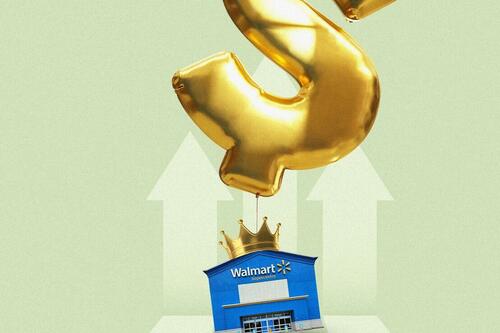How A US Retail Giant Conquered Inflation
Authored by Andrew Moran via The Epoch Times (emphasis ours),
In an economic climate of high inflation, Walmart has emerged as the retail victor, offering cheap goods to cost-conscious consumers. As millions of shoppers grapple with rising prices, the retail titan has managed to attract a wide range of customers, from low-income to high-net-worth households.
Since Walmart shares helped the Dow Jones Industrial Average march toward a record high of 40,000 on May 17, Wall Street has been delving into the company’s success story, concluding that its strong earnings have been supported by consumers hunting for bargains.
The retail titan’s shares rose by 22 percent year to date and 33 percent since last year, outperforming both the Dow Jones and S&P 500. But why has Walmart become the darling of Wall Street while other retailers, such as Target, are flatlining?
It’s all in the numbers.
Investors cheered after Walmart’s latest quarterly earnings report. Revenues advanced 6 percent year-on-year thanks to higher spending by wealthier customers and a 22 percent surge in online sales. Additionally, profits more than tripled to $5.1 billion in the three months ending on April 30.
Walmart CEO Doug McMillon attributed the company’s excellent performance to unit sales, transaction counts, and market share gains, not to price increases.
“These are not inflation-driven results,” he said during the company’s earnings call.
In addition to generating more transactions, Walmart has been trimming the fat to keep costs down, such as a 4.2 percent drop in inventory levels.
During the pandemic-era supply chain crisis, retailers scrambled to buy as much as possible to satisfy consumer demand and prevent further trade disruptions. Now that supply chains have largely normalized, backroom stock does not need to be as immense.
Looking ahead, shoppers may notice lower store prices for various merchandise. The company noted that it has bolstered “rollbacks” on thousands of specific items in both brick-and-mortar locations and the website.
“Our rollback count is up and customers are responding to our price leadership,” Mr. McMillon said.
All of these trends helped the Arkansas-based retailer lift its market cap above $500 billion and bring the share price to around $65.
“Despite the broader economic pressures of inflation, Walmart has navigated the turbulent waters with aplomb,” said Giuseppe Sette, the president of financial market research services firm Toggle AI, used by leading hedge funds and Wall Street banks.
“The broader implication here is clear: Walmart is not only a barometer for the retail sector but also for the U.S. economy at large.”
By comparison, Target has a market cap of about $67 billion and its shares are up just 3.2 percent year-to-date as of May 29.
The Rich Visit Walmart
Since its inception, Walmart has been known as a discount department store behemoth that typically appeals to low- and middle-income shoppers.
In today’s high cost-of-living climate, the retail giant confirmed it is attracting more upper-income households, too.
“Wallets are still stretched,” said Walmart CFO John David Rainey in the earnings call.
While value had been the premier objective of visiting the retailer, the corporate giant noted that consumers are searching for quality and convenience, too.
This should not be surprising news, says Carol Levenson, the director of research at Gimme Credit.
“It is the convenience as well as the value and assortment that attracts them, just as it does any shopper,” Ms. Levenson told The Epoch Times.
Walmart has been doing a lot to appeal to a wider range of customers, such as launching a new private-label grocery brand, upgrading more than 1,400 locations nationwide, and stocking shelves inside renovated stores with newer kitchen and fashion brands.
In recent years, discount retailers like Dollar General and Five Below have reported higher-income shoppers flocking to their stores, Morning Consult data show. Big Lots has said upper-income customers account for more foot traffic than in prior years.
One area that invites more consumers of all demographics is the grocery aisles.
America’s Grocery King
Walmart is, by far, the largest grocery retailer in the United States. And amid soaring prices, an increasing number of Americans are flocking to Walmart for their grocery needs.
Ms. Levenson noted that Walmart dominates because of its immense grocery and essentials base, which accounted for 72 percent of its U.S. sales last year. Its feet have been firmly planted at the top of the retail mountain because of “its geographic and assortment breadth, meaning it can sail through economic cycles and consumer spending trends, aided by its scale and its financial flexibility.”
“In grocery, it has recently introduced some higher quality private brands priced and positioned more like Trader Joe’s, likely aimed at upper-income households,” she said.
Consumers are shifting their spending habits, too, especially in the realm of food.
As fast food becomes more expensive, Walmart is attracting customers who are hunting for better deals. Grocery sales were up by mid-single-digit percentages, buoyed by meat and produce, the company reported in its recent earnings report.
The latest inflation report also shows a widening gap between food-at-home prices and food-away-from-home prices. In the April consumer price index report, for example, the former was up 1.1 percent year-over-year, and the latter was up more than 4 percent compared to the same time a year ago.
Read more here…
Tyler Durden
Fri, 05/31/2024 – 13:40
